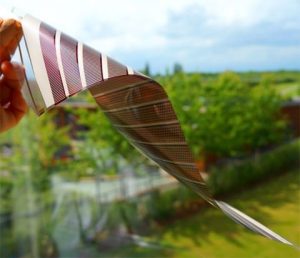Research into increasing the efficiency of polymer solar cells (PSCs) has led to indium tin oxide (ITO) becoming the material-of-choice for the required transparent conducting layer. Yet this material brings its own disadvantages, particularly in terms of large-scale production. In their fascinating review published in the Journal of Applied Polymer Science Dechan Angmo and Frederik C. Krebs at the Technical University of Denmark discuss current alternatives to ITO that aim to overcome the most recent hurdles that have emerged in this field.
 PSCs have the potential to supply a significant amount of the world’s energy provided from renewable resources. Moreover, they boast several advantages over the costly and complicated to produce silicon-based solar cells that are mostly in use today. PSCs use inexpensive materials, are light weight, can be made flexible and are easily manipulated. These attributes mean they lend themselves to roll-to-roll processing for production on a large-scale, significantly reducing manufacturing expenditure compared to their silicon-based counterparts. Unfortunately however, the introduction of ITO raises the overall cost of fabrication: processing ITO requires high temperatures and vacuum-based high energy deposition methods. Additionally, scarce supplies and increasing demand (in part thanks to its use in the display industry) has led to substantial price fluctuations of indium. Efforts are now being made to find a low-cost replacement to ITO that does not suffer from supply concerns, is flexible, is solution-based, can be processed in a vacuum-free environment, and is not detrimental to PSC efficiency.
PSCs have the potential to supply a significant amount of the world’s energy provided from renewable resources. Moreover, they boast several advantages over the costly and complicated to produce silicon-based solar cells that are mostly in use today. PSCs use inexpensive materials, are light weight, can be made flexible and are easily manipulated. These attributes mean they lend themselves to roll-to-roll processing for production on a large-scale, significantly reducing manufacturing expenditure compared to their silicon-based counterparts. Unfortunately however, the introduction of ITO raises the overall cost of fabrication: processing ITO requires high temperatures and vacuum-based high energy deposition methods. Additionally, scarce supplies and increasing demand (in part thanks to its use in the display industry) has led to substantial price fluctuations of indium. Efforts are now being made to find a low-cost replacement to ITO that does not suffer from supply concerns, is flexible, is solution-based, can be processed in a vacuum-free environment, and is not detrimental to PSC efficiency.
The alternatives explored in the review are classified in to four main groups: polymers; metal and polymer composites; metal nanowires and ultra-thin metal films; and carbon nanotubes and graphene. A particular emphasis is placed on large-scale production and includes a description of a scalable, mass-produced ITO-free module that the authors have created. Indeed this, along with other developments in the field means that Krebs is now confident that the latest technology is ready to be used on a utility-scale, “I think that we will see bulk electricity being produced for the grid in 2013 from solar parks based on organic photovoltaics”.

















